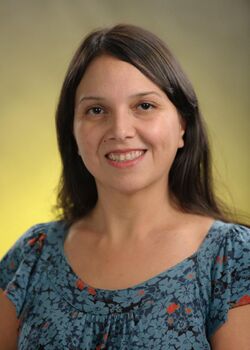Biography:Elisa Quintana
Elisa Victoria Quintana | |
|---|---|
 Quintana backed by an artist's impression of Kepler 186f | |
| Born | 1973 (age 51–52) |
| Alma mater | University of Michigan, Grossmont College, University of California at San Diego |
| Known for | Astronomy |
| Scientific career | |
| Fields | Astronomy |
| Institutions | Astrophysicist NASA Goddard Space Flight Center |
| Doctoral advisor | Fred Adams |
Elisa Victoria Quintana is a scientist working in the field of astronomy and planetary science at NASA Goddard Space Flight Center. Her research focuses the detection and characterization of exoplanets in addition to studying how they form. She is best known for the detection of Kepler 186f,[1] the first Earth-sized planet found in the habitable zone of a star other than the Sun.[2][3]
Early life and education
Quintana was born in Silver City, New Mexico.[4] Her father Leroy Quintana, is a Chicano poet and her grandfather was a miner who appeared in blacklisted movie Salt of the Earth. Aged 9 she moved to San Diego. She attended Grossmont College and transferred to the University of California at San Diego where she obtained a Bachelor of Science degree in Physics. During her time as an undergraduate Quintana worked on astrodynamics the KidSat program (later renamed EarthKAM) with first US woman astronaut Sally Ride who was a professor in San Diego.
She received Master's degrees in both Aerospace Science and Physics from the University of Michigan and earned her PhD in Physics from the University of Michigan in 2004. Her PhD thesis for on the topic of planet formation in binary star systems. Quintana was amongst the first people to study whether planets could form in the Alpha Centauri system.[5]
Academic career
Quintana was a member of the NASA Kepler Mission Team at NASA Ames Research Center from 2006 to 2017. She worked as a scientific programmer developing the Kepler pipeline, for which she was awarded the NASA Software of the Year in 2010.[6] She was part of the team that discovered the first rocky exoplanet Kepler-10b, the first exoplanet to orbit the habitable zone of another star Kepler-22b, and the first Earth-sized exoplanet Kepler-20e. In 2014, she led the team that discovered Kepler-186f, an earth-sized exoplanet orbiting in the habitable zone a red dwarf star,[7] which was published in the journal Science.[8] Quintana received the 2015 Scientist of the Year award from Great Minds in STEM for her discovery of Kepler-186f and contribution to science.[9][10]
Quintana has been studying the frequency of giant impacts on exoplanets and comparing how their frequency compares with Earth.[11][12] In 2017, she moved to the Goddard Space Flight Center in Maryland, where she serves as Deputy Project Scientist for the Nancy Grace Roman Space Telescope (formerly known as the Wide Field Infrared Survey Telescope) and Deputy Project Scientist for the Transiting Exoplanet Survey Satellite.
Quintana is one of the few female Hispanic scientists in astronomy.[13] Her contributions to the Latino community were recognized when the Los Angeles Theatre Center awarded her the 2014 Lupe Ontiveros Dream Award.[14]
Awards and honors
This section of a biography of a living person does not include any references or sources. (July 2020) (Learn how and when to remove this template message) |
- Hispanic Engineers National Achievement Awards Scientist of the Year (2015)
- Lupe Ontiveros Dream Award (2014)
- NASA Software of the Year (2010)
References
- ↑ Chang, Kenneth (17 April 2014). "Scientists Find an 'Earth Twin', or Maybe a Cousin". The New York Times. https://www.nytimes.com/2014/04/18/science/space/scientists-find-an-earth-twin-or-maybe-a-cousin.html.
- ↑ Chang, Alicia (17 April 2014). "Astronomers spot most Earth-like planet yet". Associated Press. Archived from the original on 2014-04-18. https://web.archive.org/web/20140418172517/http://apnews.excite.com/article/20140417/DAD832V81.html.
- ↑ Morelle, Rebecca (17 April 2014). "'Most Earth-like planet yet' spotted by Kepler". BBC News. Archived from the original on 2014-04-18. https://web.archive.org/web/20140418172858/http://www.bbc.co.uk/news/science-environment-27054366.
- ↑ Lartaud, Derek (7 January 2016). "Career Spotlight: The Planet-Searching Physicist". KQED. http://ww2.kqed.org/quest/2016/01/07/career-spotlight-the-planet-searching-physicist/.
- ↑ Quintana, E. V.; Lissauer, J. J.; Chambers, J. E.; Duncan, M. J. (2002). "Terrestrial Planet Formation in the Alpha Centauri System". Astrophysical Journal 2, part 1 (2): 982–996. doi:10.1086/341808. Bibcode: 2002ApJ...576..982Q.
- ↑ "NASA's Kepler Mission Wins 2010 Software Of The Year Award". NASA. http://www.nasa.gov/home/hqnews/2010/oct/HQ_10-245_Kepler_Software_Award.html.
- ↑ "Kepler-186f, the First Earth-size Planet in the Habitable Zone". NASA. 3 March 2015. http://www.nasa.gov/ames/kepler/kepler-186f-the-first-earth-size-planet-in-the-habitable-zone.
- ↑ Quintana, E. V.; Barclay, T.; Raymond, S. N.; Rowe, J. F.; Bolmont, E.; Caldwell, D. A.; Howell, S. B.; Kane, S. R. et al. (2014-04-18). "An Earth-Sized Planet in the Habitable Zone of a Cool Star". Science 344 (6181): 277–280. doi:10.1126/science.1249403. PMID 24744370. Bibcode: 2014Sci...344..277Q.
- ↑ "2015 HENAAC Award Winners". Great Minds In STEM. http://www.greatmindsinstem.org/professionals/award-winners-2015.html.
- ↑ "2015 GMiS HENAAC Awards Part 12 – Charles Bolden Message, Scientist of the Year Dr. Elisa Quintana" on YouTube
- ↑ Quintana, E. V.; Barclay, T.; Borucki, W. J.; Rowe, J. F.; Chambers, J. E. (2016). "The Frequency of Giant impacts on Earth-like Worlds". Astrophysical Journal 821 (2): 126. doi:10.3847/0004-637X/821/2/126. Bibcode: 2016ApJ...821..126Q.
- ↑ Kohler, Susanna (9 May 2016). "Giant Impacts on Earth-Like Worlds". American Astronomical Society. http://aasnova.org/2016/05/09/giant-impacts-on-earth-like-worlds/.
- ↑ "Research Scientist Highlight: Dr. Elisa Quintana". Astronomy in Color. 8 March 2016. http://astronomyincolor.blogspot.com/2016/03/professional-highlight-dr-elisa-quintana.html.
- ↑ "Dr. Elisa Quintana receives the Lupe Ontiveros Dream Award". Space Science and Astrobiology at Ames. NASA Ames Research Center. http://spacescience.arc.nasa.gov/story/dr-elisa-quintana-receives-lupe-ontiveros-dream-award.
 |

